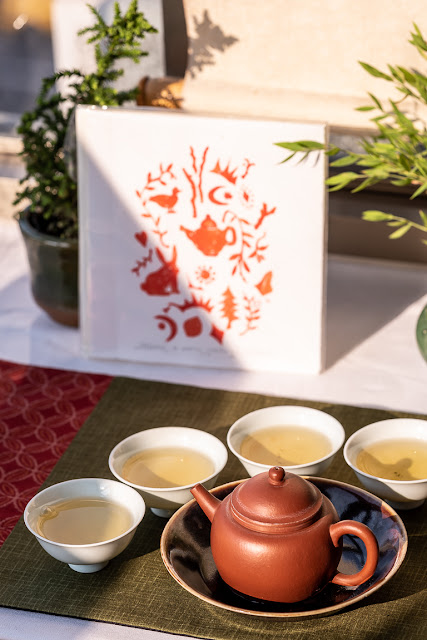I thought I'd illustrate this book with a small Chaozhou teapot in which I'm brewing a winter 2017 Hung Shui Jinxuan Oolong from Dong Ding. This type of red clay is rather soft and porous. It's a good fit for medium to high roasted Oolongs.
The shape of Chaozhou (or Chaoshan or Shantou) teapots will bear resemblance to that of very classical, small Yixing teapots. The difference in making these teapots is that Chaozhou teapots are wheel thrown. The other difference is barely noticeable. It's the shape of the mouth of the spout! While it's mostly round in Yixing, Chaozhou teapots usually have a slightly pointed mouth (enlarge the picture to see it).
Shantou clay is always red and it appears glossy because the teapot is covered with a bright red glaze, because otherwise the raw glaze would look quite dull. It seems as if the teapot had already been seasoned for some time! And in terms of taste, it manages to lower the roasting aromas and bring a lot of freshness from the leaves into the brew!
 |
| Spring 2018 RouGui Baozhong |
For this Chaxi, I'm brewing a spring 2018 RouGui Baozhong in an Yixing Zhuni teapot from the 1980s. By showing a teapot in a Chaxi, I stress the point that teapots are not made and collected for their own sake, but that their primary function is to make tea, and to make it well!
But once the tea tastes right and beautiful, it enables you to enter a world of art, culture and poetry. The title of this article was inspired from this book, because I read that Gu Jingzhou liked Su DongPo's poem 'Leaving footprints in the snow' (願留鴻爪踏雪泥). The 1999 footprints refer to the fact that this is my 1999th article on this blog! (A big celebration for the 2000th article is coming!)
And the biggest reason why I continue writing is because I have the kindest and most wonderful readers, tea lovers from around the world. That's why this Chaxi features this painting from my tea friend Elisabeth, in Canada. That's where they literally know what it means to leave a footprint in the snow! Here, of course, it means creating a fleeting moment of tea art and taste. It's a great feeling to be connected to so many people who are intimately touched by their tea experiences!
The brew has a very clear yellow color in the light celadon cups. That's a sign of above normal oxidation. The leaves are indeed green inside and red on the edges (like this Chabu!) The aromas of this Wenshan Baozhong differ greatly from high mountain Oolong. The forest flower fragrances and soft Chinese spices aromas gives this Baozhong a very distinctive and complex scent.The hard zhuni clay helps to extract the finest fragrances from this fresh Baozhong by opening the leaves completely and absorbing very little aroma. Tea can replace wine and give us inspiration to find beauty and poetry in each cup!


















1 comment:
Hi Stéphane,
'Tea friendship' is certainly precious and has opened so many windows for me, with more and more to learn, experience and enjoy. Thank you truly for all that you share!
Best,
Elisabeth
Post a Comment